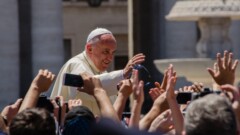This evening’s session began with Rick Holland reminding the audience of a young man named Ryan Gay. Ryan had wanted to attend Resolved last year but was unable to as he was diagnosed with leukemia just a day or two before the conference began. Last year Holland called him from the stage during the conference and it was, by all accounts, an emotional and spiritual time. Tonight, a year later, Holland invited Ryan to the stage. He was able to be there this year along with his wife of eight days. Ryan spoke of the encouragement he received last year, of his battle with cancer, and the lessons he learned through this trial.
After a time of corporate worship through singing, John MacArthur again opened the Word, this time preaching from Luke 18 and the story of the Pharisee and the tax collector.
He began by stating that the Old Testament is full of references to justification: Job 9:2 (how can a man be made righteous before God?); Psalm 143:2 (in God’s sight no man living is righteous); etc. The Old Testament believers understood the concept of justification. They knew that there are only two possible answers to the sin problem: either you can do it on your own or you can’t. And thus there are only two religions in the world: religions of human accomplishment and religions of divine accomplishment. This story shows both of these groups. Pharisees were self-righteous, confident, assured, contemptuous. The pharisee comes before God in this story and asks for nothing: no forgiveness, no grace, no mercy. Nothing! He doesn’t think he needs anything. On the other hand is this tax collecter: sinful, outcast, guilty, alienated, distraught, humble, broken, desperate and begging for mercy.
The Pharisees had great influence in the populace because they plied their system through the synagogues. It was this religion of the Pharisees that was seen throughout the land. They were the benchmark people of the religion. They thought they could achieve righteousness before God by their own efforts. Anybody beneath them was considered with contempt and disdain. Though many years later, Martin Luther was one of these. He had convinced himself that he was the most fastidious and scrupulous of all monks. He knew that he felt far short of the divine and perfect standard but thought of divine righteousness as a horrible thing. He thought his condition was hopeless and this is what started him on a path to a true righteousness. For much of his life he was a pharisee.
Set against the pharisee is the tax collector. In Jewish society, tax collecters were the absolute lowest of the low. They were regarded as idolatrous traitors. So in this story you have what people regarded as the pinnacle of religion and then the very bottom. With these characters in mind, Jesus told His story.
Two men went to the temple to pray. This would be a time of prayer, sacrifice, blessing and praise. An animal would be sacrificed as an act of atonment for the sins of the people. This was a very elaborate ceremony. The faithful came and watched as the sacrifice was made and the incense was burned (symbolizing their ability to pray to God). And in this setting we meet the two characters.
The Pharisee stood to pray and probably did so in a prominent place. He likely stood as close to the sacrifice, as close to the Holy Place, as he could get (since he thought he deserved to be there). He wanted others to see him and to see his holiness. He prayed in a way that was self-congratulatory (as seen in his five references to himself in his prayer). He is celebrating his self-righteousness openly and publicly). He doesn’t even offer praise to God. His thanks is a mockery. This is obnoxious self-righeousness. This is not even prayer – he is just talking to himself and wanting others to hear how holy he is so they will be able to compare him to the unclean reject.
And then there was the tax collecter. He stood some distance away, far from the Holy place, probably in the outer court reserved for the Gentiles. He knows he is unclean and despised. He is a sinner before all the people and before God. He knows and feels his alienation. You can see this in his place but also in his posture. He refused to even lift up his eyes to God for he was too filled with shame and guilt. He feels and knows and acknowledges his sin. There isn’t any word to mitigate this. He feels the full weight of his disobedience and sin, knowing that God is his enemy and his judge. His behavior also says this. He crosses his hands across the chest with his eyes down. He begins to pound his chest rapidly and repeatedly, an act that never appears in the Old Testament and only appears in the New Testament here and at the crucifixion of Jesus. It happens today in many middle eastern cultures where women wail and pound their chests during times of emotional distress. Rarely do men do this. It takes something of the magnitude of Jesus’ death for middle eastern men to behave like this–it was a female gesture to be this sorrowful, this penitent. It was a sign of weakness. But in this story the tax collector pounds his chest to pound his heart, the source of all evil.
From this shame and anguish comes a prayer–a real prayer. “God be merciful to me the sinner.” He really prays to God and asks for something only God can do. He asks for forgiveness, reconciliation. Faith is there, for he believed in God, believed that God is holy and believed that God is forgiving. His plea for God to be merciful is really a plea for God to “propitiate.” He is saying “be propitious toward me.” That is, “God, accept this atonement on my behalf. Accept satisfaction.”
The tax collector goes home justified rather than the other. This is stunning to a Jewish audience. Their whole religious system was based on the idea that a person can make himself righteous by his own morality and religion. Pharisees were the very archetype of this righteousness, but Jesus shatters this illusion. Jesus’ final words would have shocked the listeners. They would have been stunned. In one moment Jesus pronounces an extreme sinner righteous apart from any works, merit, worthiness, law-keeping, ritual or ceremony. He is instantaneously justified. How can this be? We know because it unfolds in the rest of the New Testament. The key is that Jesus’ righteousness was credited to this man’s account. The sin problem was dealt with and propitiation was made. The man who pleaded for mercy was granted mercy while the man who depended on his own goodness was cast off.
The purpose of this session was to help those in attendance to see their sin, to see their unworthiness, and to embrace the Savior who has done it all. If there are only two kinds of religion in the world, we need to embrace the one that provides the perfect Savior to hold out forgiveness to imperfect sinners.
If you are interested in some top-notch photos from the conference, click here. These are courtesy of Lukas Van Dyke. Tip: you can use the arrow keys on your keyboard to navigate through the photos.









